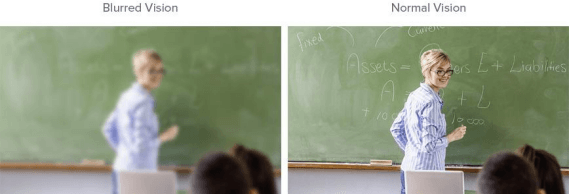Pediatric Eye Care Services
Pediatric vision examination is done to diagnose vision disorders like refractive errors, lazy eye (amblyopia), squint (strabismus), or other abnormalities at an early age. Unfortunately, undue reliance on vision screening by pediatricians or other primary care physicians may result in the late detection of amblyopia and other vision disorders.
Within the first 6 months of life, rapid changes occur in most components of the visual system including visual acuity, accommodation, and binocular vision. Interference with development during this very critical phase may lead to serious lifelong effects on vision. Successful treatment can be obtained more quickly with early intervention.
As Clinicians, we have gained a better understanding of both the characteristics and processes of vision development in infants and the tools necessary to examine them. As a result, it is now recommended that all children receive regular, professional eye care beginning at 6 months of age after an initial eye screening at birth, typically performed by the pediatrician.
Goals of the pediatric eye examination:
•Evaluate the functional status of the eyes and visual system, taking into account each child’s level of development.
•Assess ocular health and related systemic health conditions.
•Establish a diagnosis and formulate a treatment plan.
•Counsel and educate parents/caregivers regarding their child’s visual, ocular, including recommendations for treatment, management, and preventive care.
Refractive errors
Refractive errors occur when the shape of the eye prevents light from focusing directly on the retina. The length of the eyeball (longer or shorter), changes in the shape of the cornea, or aging of the lens can cause refractive errors.
There are different types of refractive errors.
Myopia:(nearsightedness) is a condition where objects far away appear blurry
Hypermetropia:(farsightedness) is a common type of refractive error where distant objects may be seen more clearly than objects that are near. For people with significant hyperopia, vision can be blurry for objects at any distance, near or far
Astigmatism: The condition in which the eye does not focus light evenly onto the retina. This can cause images to appear blurry and stretched out.
All these conditions can be treated with power glasses, contact lenses, or with refractive surgery [after a certain age, according to the power].

Amblyopia
Amblyopia is the medical term used when the vision in one of the eyes is reduced because the eye and the brain are not working together properly. The eye itself looks normal, but it is not being used normally because the brain is favoring the other eye. This condition is also sometimes called lazy eye. This can be treated if detected at an early age, with glasses and patching therapy.
Strabismus
Strabismus, also called crossed eyes is a condition in which both eyes do not look at the same place at the same time. It usually occurs in people who have poor eye muscle control or have high refractive errors. A variety of conditions can cause strabismus.
Six muscles attach to each eye to control how it moves. The muscles receive signals from the brain that direct their movements. Normally, the eyes work together so they both point at the same place. When problems develop with eye movement control, an eye may turn in, out, up or down. The eye turning may occur all the time or may appear only when the person is tired, ill, or has done a lot of reading or close work. In some cases, the same eye may turn each time. In other cases, the eyes may alternate turning.
Some babies’ eyes may appear to be misaligned, but they are actually both aiming at the same object. This is a condition called pseudostrabismus or false strabismus. The appearance of crossed eyes may be due to extra skin that covers the inner corner of the eyes or a wide bridge of the nose. Usually, the appearance of crossed eyes will go away as the baby’s face begins to grow.
The goal of strabismus treatment is to improve eye alignment which allows for the eyes to better work together (binocular vision). Treatment may involve eye glasses, eye exercises, prism, and/ or eye muscle surgery. Problems associated with strabismus (including amblyopia, ptosis, and cataract) are usually treated prior to eye muscle surgery.
Droopy eyes
Child can be born with droopy eyelids. If it covers the visual axis of the eyes, it is a matter of concern and need immediate attention.Because, this may prevent the vision development and lead to lazy eye. It can be corrected surgically.Because, this may prevent the vision development and lead to lazy eye. It can be corrected surgically.

Surgical correction required if it covers the visual
axis as it may cause ‘lazy eye’ otherwise.

Watery eyes
Watering of the eyes in children is due to blockage of the tear drainage system due to maldevelopment at birth. Often it resolves spontaneously by the age of 1year with good eye massage. Rarely it can get infected and lead to complications. Absence of resolution at 1 year will require intervention to clear the passage.
